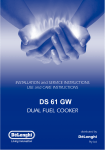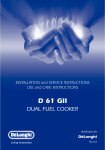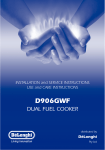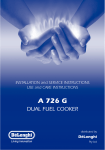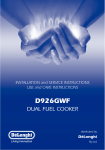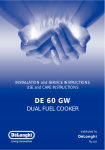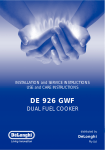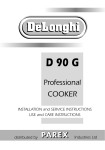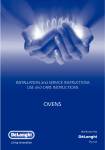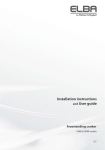Download DeLonghi L61GW Specifications
Transcript
INSTALLATION and SERVICE INSTRUCTIONS USE and CARE INSTRUCTIONS L61GW DUAL FUEL COOKER distributed by DèLonghi Pty Ltd Dear Customer, Thank you for having purchased and given your preference to our product. The safety precautions and recommendations reported below are for your own safety and that of others. They will also provide a means by which to make full use of the features offered by your appliance. Please keep this booklet in a safe place. It may be useful in future, either to yourself or to others in the event that doubts should arise relating to its operation. This appliance must be used only for the task it has explicitly been designed for, that is for cooking foodstuffs. Any other form of usage is to be considered as inappropriate and therefore dangerous. The manufacturer declines all responsibility in the event of damage caused by improper, incorrect or illogical use of the appliance or be faulty installation. PRODUCT LABEL 2 FIRST TIME USE THE OVEN It is advised to follow these instructions: Clean the interior of the oven with cloth soaked in water and detergent (neutral) then dry carefully. ■ Fit the wire racks as described at chapter “Use and care”. ■ Insert shelves and tray. ■ Switch on the empty oven on max to eliminate grease tracks from the heating elements. ■ IMPORTANT PRECAUTIONS AND RECOMMENDATIONS FOR USE OF ELECTRICAL APPLIANCES Use of any electrical appliance implies the necessity to follow a series of fundamental rules. In particular: ■ Never touch the appliance with wet hands or feet; ■ Do not operate the appliance barefooted; The appliance is not intended for use by young children or infirm persons with supervision ■ Young children should be supervised to ensure they do not play with the appliance The manufacturer cannot be held responsible for any damages caused by improper, incorrect or illogical use of the appliance. ■ 3 IMPORTANT PRECAUTIONS AND RECOMMENDATIONS After having unpacked the appliance, check to ensure that it is not damaged. In case of doubt, do not use it and consult your supplier or a professionally qualified technician. Packing elements (i.e. plastic bags, polystyrene foam, nails, packing straps, etc.) should not be left around within easy reach of children, as these may cause serious injuries. ■ Do not attempt to modify the technical characteristics of the appliance as this may become dangerous to use. ■ Do not carry out cleaning or maintenance operations on the appliance without having previously disconnected it from the electric power supply. ■ After use, ensure that the knobs are in off position. ■ Do not allow children or other incapable people to use the appliance without supervision. ■ During and after use of the cooker, certain parts will become very hot. Do not touch hot parts. ■ Keep children away from the cooker when it is in use. ■ Some appliances are supplied with a protective film on steel and aluminium parts. This film must be removed before using the appliance. ■ Fire risk! Do not store flammable material in the oven. ■ Make sure that electrical cables connecting other appliances in the proximity of the cooker cannot come into contact with the hob or become entrapped in the oven door. ■ Do not line the oven walls with aluminium foil. Do not place baking trays or the drip tray on the base of the oven chamber. ■ The manufacturer declines all liability for injury to persons or damage to property caused by incorrect or improper use of the appliance. ■ IMPORTANT NOTE: This appliance shall not be used as a space heater, especially if installed in marine craft or caravans. This cooker has been designed and constructed in accordance with the following codes and specifications: AGA101 (AS 4551) Approval Requirements for Domestic Gas cooking appliances 4 AS/NZS 3350-1 General Requirements for Domestic electrical appliances AS/NSZ 3350-2-6 Particular Requirements for Domestic electrical cooking appliances AS/NSZ 1044 Electromagnetic Compatibility Requirements. INSTALLATION CAUTION: ■ ■ ■ ■ ■ ■ This appliance must be installed in accordance with these installation instructions. This appliance shall only be serviced by authorized personnel. This appliance is to be installed only by an authorised person. Incorrect installation, for which the manufacturer accepts no responsibility, may cause personal injury of damage. Always disconnect the cooker from mains power supply before carrying out any maintenance operations or repairs. In the room where the cooker is installed, there must be enough air to allow the gas to burn correctly, according to the current local regulations. ELECTRICAL REQUIREMENTS The appliance must be connected to the mains checking that the voltage corresponds to the value given in the rating plate and that the electrical cable sections can withstand the load specified on the plate. ■ The plug must be connected to an earthed socket in compliance with safety standards. ■ If the appliance is supplied without a plug, fit a standard plug which is suitable for the power consumed by the appliance. ■ The appliance must be connected directly to the mains placing a two pole switch with minimum opening between the contacts of 3 mm between the appliance and the mains. ■ The power supply cable must not touch the hot parts and must be positioned so that it does not exceed 50°C above ambient. ■ Once the appliance has been installed, the switch or socket must always be accessible. ■ If the supply cord is damaged it must be replaced by the manufacturer or it’s Service Agent or a similarly qualified person in order to avoid a hazard. ■ WARNING: This cooker must be connected to electrical supply using V105 insulated cable. N.B. The connection of the appliance to earth is mandatory. If the installation requires alterations to the domestic electrical system call a qualified electrician. He should also check that the socket cable section is suitable for the power drawn by the appliance. 5 CLEARANCES Installation clearances and protection of combustible surfaces shall comply with the current local regulations eg. AG 601 (AS 5601) Gas Installations code. Installation shall comply with the dimension in Fig 1 bearing in mind that Overhead Clearances In no case shall the clearances between the highest part of the cooker be less than 600mm or for an overhead exhaust fan 750mm. AII other downward facing combustible surfaces less than 600mm above the cooker surface shall be protected for the full width of the cooking surface in accordance with the standards noted above. In no case shall the clearance be less than 450mm. Rear and Side Clearances Where the dimensions from the periphery of the nearest burner to any vertical combustible surface is less than 200mm the surface shall be protected in accordance with the standards to a height of not less than 150mm above the cooking surface for the full width or depth of the cooking surface Where the dimensions from the periphery of the nearest burner to any horizontal combustible surface is less than 200 mm, the horizontal surface shall be greater than 10 mm below the surface of the hob, or the horizontal surface requirement above. Protection of combustible surfaces. The standards above specify that where required protection shall ensure that the surface temperature of the combustible surface does not exceed 65°C above room temperature. If the cooker is located on a pedestal it is necessary to provide safety measures to prevent falling out. 500 mm 6 450 mm 750 mm Figure 1 105 mm Cooker overall dimensions [mm] • height: min 900 - max 935 • width: 600 • depth: 600 ANTI-TILT BRACKET Warning: This appliance must be restrained to prevent accidental tipping by fitting a bracket to the rear of the appliance and securely fixing it to the wall. Fixing the anti-tilt bracket: ■ After you have located where the cooker is to be positioned mark, on the wall, the place where the 2 screws of the anti-tilt bracket have to be fitted. Please follow the indications given in the drawing below. ■ Make two holes of diameter 8mm diameter on the wall and insert the plastic plugs. ■ Attach the anti-tilt bracket loosely by means of 2 screws. ■ Move the cooker to the wall and adjust the height of the anti-tilt bracket so that it can engage in one slot of the cooker back. ■ Attach the anti-tilt bracket tight. ■ Push the cooker against the wall so that the anti-tilt bracket is fully inserted in one slot of the cooker back. Figure 2 600 mm 365 235 min 105 max 140 0 + 35 7 LEVELLING The cooker is equipped with 4 levelling feet which must be fitted to the base of the cooker in the following manner: ■ Place the cooker on its back as shown in the figure 3. ■ Screw the 4 leveling feet to the cooker. ■ Stand the cooker and level it by screwing or unscrewing the feet with a spanner. Figure 3 8 GAS SUPPLY: ■ The connection must be performed by an authorised person according to the relevant standards. ■ Before connecting the appliance to the gas main, mount the brass conical adaptor onto the gas inlet pipe, upon which the gasket has been placed (figs. 4-5). Conical adaptor and gasket are supplied with the appliance (packed with conversion kit for use with Natural gas or Propane gas). ■ This appliance is suitable for use with Natural Gas or Propane gas. (Check the “gas type” sticker attached to the appliance). ■ For Natural Gas models the gas supply is connected to the pressure regulator which is supplied with the appliance (fig. 5). Adjust the regulator to obtain a test point pressure of 1 kPa with the two semi-rapid (SR) burners operating at maximum. ■ For Propane gas models the gas supply is connected to the test point adaptor which is supplied with the appliance (fig. 4) and ensure that the supply pressure is regulated to 2.75 kPa. ■ The connection must be made at the rear of appliance (left or right); the pipe does not cross the cooker. ■ The inlet not used must be closed off with the cap and sealing gasket supplied. ■ IMPORTANT: Use two spanners to tighten or loosen the connecting pipe (fig. 6) Figure 4 Figure 5 Gas connection for PROPANE GAS Gas connection for NATURAL GAS Gas inlet pipe Gas inlet pipe Nipple Nipple Gasket Gasket Brass conical adaptor (Thread tight: use suitable seal) Test point Brass conical adaptor (Thread tight: use suitable seal) Test point adaptor Gas regulator Test point 9 1. After connecting the gas supply, check the piping and connections for leaks using a soap and water solution. The presence of bubbles indicates a leak, tighten or replace connections as appropriate. Warning: Do not use any naked flame to check for leaks. 2. Adjust the test point pressure or supply pressure to the value which is appropriate for the gas type. 3. The operation of the appliance must be tested when installation is completed. 4. Turn on the appliance gas controls and light each burner individually and in combination. Check for a well defined blue flame without any yellow tipping. If any abnormality is evident then check that the burner cap is located properly and the injector nipple is aligned correctly. 5. Check the minimum burner setting by quickly rotating the gas control knob from the maximum to the minimum position, the flame must not go out. If adjustment is required carry out the “minimum burner setting adjustment" procedure described 6. If satisfacfory performance cannot be obtained, the installer shall check the installation and notify the local gas supply authority for a gas supply problem, or if it is an appliance problem, our Customer Service Centre should be called to obtain the nearest authorized Delonghi Service Agent. WARNING, This appliance IS NOT SUITABLE for installation with a hose assembly. Figure 6 Figure 7 Plug 10 CONVERSION PROCEDURE (to convert to LPG Propane) REPLACING THE INJECTORS This appliance is suitable for use with Natural gas or Propane gas (check the “gas type” sticker attached to the appliance). A label stating the type of gas used after replacing the injectors must be attached at the rear of the appliance, in proximity of the gas inlet connection. The nominal gas consumption and injector size details are provided in table at page 13. To replace the injectors proceed as follows: ■ Remove pan supports and burners from the cooktop. ■ Using a spanner, remove the injector J (figs. 8-9) and replace it with one according to the gas type (see following tables - page 13). ■ Affix to the rear of the appliance, in proximity of the gas inlet connections, the warning label (supplied with the conversion kit) stating that the cooker has been converted for use with Propane gas / Natural gas. IMPORTANT ■ If the cooker is suitable for use with Natural gas and must be converted for use with Propane gas, before connecting to gas main remove the appliance gas regulator and replace with test point adaptor (see figs. 4-5) ■ If the cooker is suitable for use with Propane gas and must be converted for use with Natural gas, before connecting to the gas main remove the appliance test point adaptor and replace with gas regulator (see figs. 4-5). NOTE: Gas regulator and test point adaptor are supplied with the appliance (packed with conversion kit) The burners are designed so that regulation of primary air is not required. Figure 8 Figure 9 J J 11 MINIMUM BURNER SETTING ADJUSTMENT Check whether the flame spreads to all burner ports when the burner is lit with the gas tap set to the minimum position. If some ports do not light, increase the minimum gas rate setting. Check whether the burner remains lit even when the gas tap is turned quickly from the maximum to the minimum position. If the burner does not remain lit, increase the minimum gas rate setting. The procedure for adjusting the minimum gas rate setting is described below. Turn on the burner ■ Turn the tap to the MINIMUM position ■ Take off the knob ■ With a small flat screwdriver turn the screw (fig. 10) to the correct regulation. ■ Normally for Propane gas, the regulation screw is tightened up. Figure 10 12 TABLE FOR THE CHOICE OF THE INJECTORS Natural gas Propane gas 1.0 Test Point Pressure [kPa] 2.75 Injector Orifice Dia. Gas Consumption Injector Orifice Dia. Gas Consumption [mm] [MJ/h] [mm] [MJ/h] Auxiliary (A) 0.85 3.60 0.53 3.60 Semi-rapid (SR) 1.12 6.30 0.70 6.30 Triple ring (TC) 1.65 13.30 0.95 11.90 BURNER LUBRICATION OF THE GAS TAPS If the gas tap becomes stiff, it is necessary to dismantle it carefully and clean it with petroleum spirit. Specialist high temperature resistant grease should be used to lubricate the tap before replacing. The operations must be carried out by an authorised person/service agent. Figure 11 13 USE and CARE CAUTION: ■ This appliance must be used only for the task it has explicitly been designed for, that is for domestic cooking of foodstuffs. Any other form of usage is to be considered as inappropriate and therefore dangerous. ■ Do NOT place combustible materials or products on this appliance at any time. ■ Do NOT spray aerosols in the vicinity of this appliance while it is in use. Figure 12 14 Figure 13 USING THE OVEN FOR THE FIRST TIME Clean the inside of the oven with a cloth soaked in water and neutral detergent and dry thoroughly. ■ Slide in the wire racks on the oven wall as in Fig. 12. ■ ■ Slide in the grease filter on the back of the oven as in Fig. 14. ■ Position the shelf and tray as per Fig. 13. ■ To eliminate traces of grease in manufacture it is necessary to pre-heat the oven at the maximum temperature. • For 60 minutes in the tion. position and for another 15 minutes in the posi- GREASE FILTER A special screen is provided at the back of the oven to catch grease particles, mainly when meat is being roasted (fig. 14). ■ When baking pastry etc. this filter should be removed. ■ ■ Always clean the filter after cooking as any solid residues on it might adversely affect the oven performance. Figure 14 15 GAS HOB Figure 15 3 2 1 GAS BURNERS 1. 2. 3. 4. 16 Auxiliary burner (A) Semi-rapid burner (SR) Semi-rapid burner (SR) Triple ring burner (TC) 4 Natural Gas MJ/h Propane gas MJ/h 3.6 6.3 6.3 13.3 3.6 6.3 6.3 11.9 LIGHTING GAS BURNERS FITTED WITH ELECTRONIC IGNITION ■ Check that the electricity is switched on to allow spark ignition. ■ Make sure that all controls are turned to zero. ■ The gas flow to the burner is controlled by the taps. The switch for the electric ignition is incorporated in the knobs. ■ The gas flow is controlled by turning the knob indicator to line up with the following symbols. – Symbol ● Figure 16 : tap closed (burner off) – Symbol : High (maximum) – Symbol : Low (minimum) ■ To ignite automatically, push the required knob down and turn it to maximum, keeping the knob down until the burner lights ■ You can control the temperature by the knob to “High” from “minimum”. ■ To switch off, turn the knob clockwise until you hear the safety click. ■ Note that, if you are using a burner at the minimum setting, you turn the knob clockwise past the maximum setting before reaching the off position. ■ Whenever the lighting of the burners is difficult due to peculiar conditions of the gas features or supply, it is advised to repeat the ignition with the knob on “minimum” position. ■ If when lighting any of the burners an abnormal flame appears, switch the burner off and relight using the minimum setting. ■ If the flame is still not correct, turn the burner off and call our Customer Service center for your nearest Authorized Delonghi Service Agent. ■ In the case of a mains failure light the burner with a match or lighted taper. 17 CHOICE OF BURNER The burner must be chosen according to the diameter of the pans and energy required. For optimum efficiency use a wok or pan no smaller than 230mm diameter. Figure 17 do not use pans with concave or convex bases Burners Pan diameter Auxiliary Semi-rapid Triple ring Wok 12 - 14 cm 16 - 24 cm 26 - 28 cm max 36 cm Saucepans with handles which are excessively heavy, in relationship to the weight of the pan, are safer as they are less likely to tip. Pans which are positioned centrally on burners are more stable than those which are offset. It is far safer to position the pan handles in such a way that they cannot be accidentally knocked. When deep fat frying fill the pan only one third full of oil. DO NOT cover the pan with a lid and DO NOT leave the pan unattended. In the unfortunate event of a fire, leave the pan where it is and turn off all controls. Place a damp cloth or correct fitting lid over the pan to smother the flames. DO NOT use water on the fire. Leave the pan to cool for at least 30 minutes. 18 CORRECT USE OF TRIPLE-RING BURNER ■ The flat-bottomed pans are to be placed directly onto the pan-support. ■ To use the WOK, you must place the wok stand in the CORRECT position as shown in Fig. 18-19. Figure 18 Figure 19 WRONG CORRECT 19 PLURIFUNCTION ELECTRIC OVEN Figure 20 8 0 7 6 5 4 3 2 1 CONTROL PANEL - Controls description 1. 2. 3. 4. 5. 6. 7. Front right burner control knob Rear right burner control knob Rear left burner control knob Front left burner control knob 120’ timer Plurifunction oven thermostat knob Plurifunction oven switch knob Note: The electric ignition of the hob burners is incorporated in the knobs. Pilot lamp: 8. Oven thermostat indicator light GENERAL FEATURES With your new Plurifunction oven it is possible to cook a variety of food using the 4 different cooking functions. The 4 positions, thermostatically controlled, are obtained by 3 heating elements. Please note: This appliance incorporates a safety cooling fan which you will hear operating whenever the oven or grill are in use. This fan is to reduce the external temperature of the appliance and cool the internal components. 20 OPERATING PRINCIPLES Heating and cooking in the 4 function PLURIFUNCTION oven are obtained in the following ways: a. by normal convection The heat is produced by the upper and lower heating elements. b. by semi-forced convection The heat produced by the upper and lower heating elements is distributed throughout the oven by the fan. c. by radiation The heat is radiated by the infra red grill element. d. by radiation and ventilation The irradiated heat from the infra red grill element is distributed throughout the oven by the fan. Figure 21 FUNCTION SELECTOR KNOB THERMOSTAT KNOB Rotate the knob clockwise to set the oven for one of the following functions. This only sets the cooking temperature and does not switch the oven on. Rotate clockwise until the required temperature is reached (from 50 to 250°C). 21 OVEN LIGHT By setting the knob to this position, only the oven light comes on (15 W). It remains on in all the cooking modes. TRADITIONAL CONVECTION COOKING The upper and lower heating elements come on. The heat being dispersed by natural convection. The temperature range must be set between 50°C and 250°C using thermostat. The oven must be preheated before cooking. Ideal for: Food that requires the same degree of cooking both inside and out, for example roasts, spare pork ribs, meringues etc. CONVECTION COOKING WITH VENTILATION The upper and lower heating elements come on and the fan come on - the heat from the element being circulated by the fan. The temperature range can be set to between 50° and 250°C using the thermostat. Idea for: Large bulky quantities of food that require even cooking throughout for example large roasts, turkey, roast turkey, cakes etc. VENTILATED GRILL COOKING Both the grill and the fan come on. Most of the cooking is done by grilling and then the hot air circulated around the oven. The oven door should be kept closed. The temperature can be set between 50°C and 175°C maximum. The oven should be preheated for 5 minutes before cooking. For further cooking hints see “GRILLING AND COOKING AU GRATIN”. Ideal for: Quick sealing in of food juices for example such as hamburger, chicken pieces, chops. It is recommended that you do not grill for longer than 30 minutes at any one time. Attention: the oven door becomes very hot during operation. Keep children away. 22 GRILLING The infrared grill element at the top of the oven comes on. The heat is dispersed by radiation. Use with the oven door closed and the thermostat knob to position 225°C for max 15 minutes, then to position 175°C. For cooking hints, see the chapter “USE OF THE GRILL”. Ideal for: Intense grilling, browning, cooking au gratin and toasting etc. It is recommended that you do not grill for longer than 30 minutes at any one time. Attention: the oven door becomes very hot during operation. Keep children away. 23 COOKING ADVICE STERILIZATION Sterilization of foods to be conserved, in full and hermetically sealed jars, is done in the following way: a. Set the switch to position . b. Set the thermostat knob to position 175 °C and preheat the oven. c. Fill the dripping pan with hot water. d. Set the jars onto the dripping pan making sure they do not touch each other and the door and set the thermostat knob to position 130 °C. When sterilization has begun, that is, when the contents of the jars start to bubble, turn off the oven and let cool. Check your recycle book for full instructions. REGENERATION Set the switch to position and the thermostat knob to position 150° C. Bread becomes fragrant again if wet with a few drops of water and put into the oven for about 10 minutes at the highest temperature. ROASTING To obtain classical roasting, it is necessary to remember: – that it is advisable to maintain a temperature between 180° and 200 °C. – that the cooking time depends on the quantity and the type of foods. SIMULTANEOUS COOKING OF DIFFERENT FOODS The MULTI-FUNCTION oven set on position consents a simultaneous heterogeneous cooking of different foods. Different foods such as fish, cake and meat can be cooked together without mixing the smells and flavors together. This is possible since the fats and vapors are oxidized while passing through the electrical element and therefore are not deposited onto the foods. The only precaution to follow are: – The cooking temperatures of the different foods must be as close to as possible, with a maximum difference of 20° - 25 °C. – The introduction of the different dishes in the oven must be done at different times in relation to the cooking times of each one. The time and energy saved with this type of cooking is obvious. 24 GRILLING AND “AU GRATIN” As the hot air completely covers the food to be cooked, grilling may be done with the food on rack in the oven. The knob should be switched to position . The thermostat should be set to 175 °C and the oven pre-heated. The food should be placed on a rack in the oven for the required cooking time. Adding a few dabs of butter before the end of the cooking time gives the golden “au gratin” effect. It is recommended that you do not grill for longer than 30 minutes at any one time. Caution: the oven door becomes very hot during operation. Keep children well out of reach. USE OF THE GRILL Preheat the oven for about 5 minutes. Introduce the food to be cooked, positioning the rack as close to the grill as possible. The dripping pan should be placed under the rack to catch the cooking juices and fats. Grilling with the oven door closed. Do not grill for longer than 30 minutes at any one time. Caution: the oven door becomes very hot during operation. Keep children well out of reach. 25 RECOMMENDED COOKING TEMPERATURE Food °C °F Gas Mark Shelf Position* Cooking Time (approx) CAKES Victoria sandwich Small cakes/buns Maidera cake Fruit cake Rich fruit cake Scones 190 190 180 170 150 225 375 375 350 325 300 425 5 5 4 3 2 8-9 2 or 3 1 and 2 2 or 3 3 3 or 4 2 20-25 mins 15-20 mins 20 mins 13/4 hours 21/2 hours 8-10 mins PASTRY Puff Short crust Plate tarts Quiches and flans 225 200 200-210 200-210 425 400 400-410 400-410 8-9 6 6 6 2 2 1 or 2 1 or 2 10-20 mins 20-30 mins 30-35 mins 40-45 mins 225 220 230 425 425 450 7-8 7 8 2 1 or 2 2 35-55 mins 15-20 mins 20 mins 190 190 190-200 190 190 180 150-170 375 375 375-400 375 375 350 300-325 5 5 5-7 5 5 4 2-3 2 or 3 2 or 3 2 or 3 2 or 3 2 or 3 2 or 3 2 or 3 20 mins/lb + 20 mins 25-30 mins/b + 25 mins 30 mins/lb + 30 mins 30 mins/b + 30 mins 30 mins/b + 30 mins 18-20 mins/b + 20 mins 11/2 2 hours YEAST Bread loaf Bread rolls Pizza dough ROAST MEAT Beef – Medium Lamb Pork Veal Chicken Turkey up to 10lb Stews/casseroles N.B. For fan ovens reduce the temperature by 10-20°C. For any dish taking one hour or over to cook, reduce the cooking time by 10 minutes per hour. 26 * Shelf positions have been counted from the top of the oven to the base. A fan oven creates more even temperature throughout, therefore the shelf positions are not as critical. How to use the timer TIMER (Fig. 22) The timer runs the oven for a preset time. 1) Starting up After setting the function selector and thermostat to the required mode and temperature, rotate the timer knob clockwise until you reach the required cooking time (max 120 minutes). Once this time has elapsed, the timer will return to the “0” position and the oven will automatically switch off. 2) Manual position. If the cooking time is longer than two hours or if you wish to use the oven manually, switching it off as required, the knob must be turned to position . Figure 22 0 27 Cleaning and Maintenance Maintenance Period Daily Monthly 3 - 4 Yearly Description • Clean gas cooktop as per instructions below • Remove burner caps, burner rings & base and clean using non abrasive detergent & rinse in cold water & dry thoroughly before replacing back on hob • Clean ignitor tip & thermocouple using damp soapy cloth and dry thoroughly • Contact your local authorized gas Service Agent to perform a thorough check on all gas components on the gas cooker GENERAL ADVICE ■ ■ ■ ■ ■ Before you begin cleaning, you must ensure that the appliance is switched off. It is advisable to clean when the appliance is cold and especially when cleaning the enamelled parts. Avoid leaving alkaline or acidic substances (lemon juice, vinegar, etc.) on the surfaces. Avoid using cleaning products with a chlorine or acidic base. Do not use a steam cleaner because the moisture can get into the appliance thus make it unsafe. ENAMELLED PARTS All of the enamelled parts must be washed only with a sponge and soapy water or with non-abrasive products. Dry, preferably, with chamois. STAINLESS STEEL SURFACES The stainless steel front panels on this cooker (facia, bottom panel) are protected by a finger-print proof lacquer. To avoid damaging this lacquer, do not clean the stainless steel with abrasive cleaners or abrasive cloths or scouring pads. ONLY SOAP/WARM WATER MUST BE USED TO CLEAN THE STAINLESS STEEL SURFACES. GAS TAPS If the gas taps are not working properly, call our Customer Service Centre to obtain the 28 nearest Authorized Delonghi Service Agent. Figure 23 BURNERS They can be removed and washed only with soapy water. Detergents can be used but must not be abrasive or corrosive. Do not use abrasive sponges or pads. Do not put in dishwasher. After cleaning, make sure that the burnercaps, as well as the burners, have been well wiped off and CORRECTLY POSITIONED. It is essential to check that the burner flame distributor F and the cap C has been correctly positioned (see fig. 23) - failure to do so can cause serious problems. Check that the electrode “S” (fig. 23) is always clean to ensure trouble-free sparking. C F S Note: The electrode “S” must be very carefully cleaned. To avoid damage to the electric ignition do not use it when the burners are not in place. TRIPLE RING BURNER The triple ring burner must be correctly positioned (see fig. 24); the burner rib must be located in position as shown by the arrow. The burner correctly positioned must not rotate (fig. 25). Then position the cap A and the ring B (fig. 25). Figure 24 Figure 25 A B 29 OVEN ■ ■ ■ The oven with smooth enamel must be cleaned after every use, using suitable products. Please note that after using the oven for 30 minutes on the highest temperature eliminates most grime reducing it to ashes. Do not use abrasive substances to clean the oven. GRILL HEATING ELEMENT ■ The heating element is self-cleaning and does not require maintenance. GREASE FILTER ■ ■ 30 Clean the filter after any cooking! The grease filter can be removed for cleaning and should be washed regularly in hot soapy water (fig. 14). Always dry the filter properly before fitting it back into the oven. REPLACING THE OVEN LIGHT Before any maintenance is started involving electrical parts of the appliance, it must be disconnected from the power supply. The bulb must be a type resistant to high temperatures (300° C). OVEN DOOR The internal glass of the oven door can be easily removed for cleaning by unscrewing the two lateral fixing screws (fig. 26). Attention: Do not store flammable material in the oven. Figure 26 31 REMOVING THE OVEN DOOR - Type “A” Figure 28 The oven door can easily be removed as follows: ■ Open the door to the full extent (fig. 28). ■ Attach the retaining rings to the hooks on the left and right hinges (fig. 29). ■ Hold the door as shown in fig. 27. ■ Gently close the door and withdraw the lower hinge pins from their location (fig. 30). ■ Withdraw the upper hinge pins from their location (fig. 31). ■ Rest the door on a soft surface. ■ To replace the door, repeat the above steps in reverse order. Figure 29 Figure 30 Figure 27 Figure 31 32 REMOVING THE OVEN DOOR - Type “B” Figure 32 To facilitate oven cleaning, it is possible to remove the door. Please follow the instructions carefully: ■ Open the door completely. ■ Push down the lever “L” (fig. 32) and, keeping it in this position, slowly close the door in order to block the hinge. ■ Grip the door (as indicated in fig. 33) and, while closing it, release the two hinges as shown in fig. 34. L Figure 33 DOOR ASSEMBLY ■ Grip the door with your hands placed near the hinges and raise the levers “H” with your forefingers (fig. 34). ■ Insert the hinges in their position until levers “H” are hooked. ■ Open the door completely to obtain the release of levers “L”. Figure 34 H 33 Service and Maintenance If the ignition spark fails to ignite or does not light the gas, check the following items before calling our Customer Service Centre to obtain the nearest Authorised Service Agent: ■ ■ ■ Burner is reassembled and located correctly. Spark electrode and white ceramic are clean and dry. 240 VAC power supply is connected. Contact the local gas utility or our Customer Service Centre to obtain the nearest Authorized Service Agent. ■ ■ ■ You can smell gas when all burners are turned on. The burners do not remain alight at the minimum marked setting. The burner flame is yellow or emits an unusual odour. Note that a bi-annual inspection of the appliance by an authorized service agent or your locate gas utility will ensure many years of trouble free operation of your appliance. 34 WIRING DIAGRAM S1 F1 TM CC 1a 2a 3a 4a 5a 1 2 3 PA 4 5 A LF C G V S 1131308 T TL M L N ELECTRIC DIAGRAM KEY F1 TM TL CC LF C G S Oven switch Oven thermostat Thermal overload Oven cut off Oven lamp Top element Grill element Bottom element V S1 PA A M T Fan Thermostat pilot lamp Ignition switches group Ignition coil Terminal block Earth connection Descriptions and illustrations in this booklet are given as simply indicative. The manufacturer reserves the right, considering the characteristics of the models described here, at any time and without notice, to make eventual necessary modifications for their construction or for commercial needs. 35 cod. 1102327 ß3




































